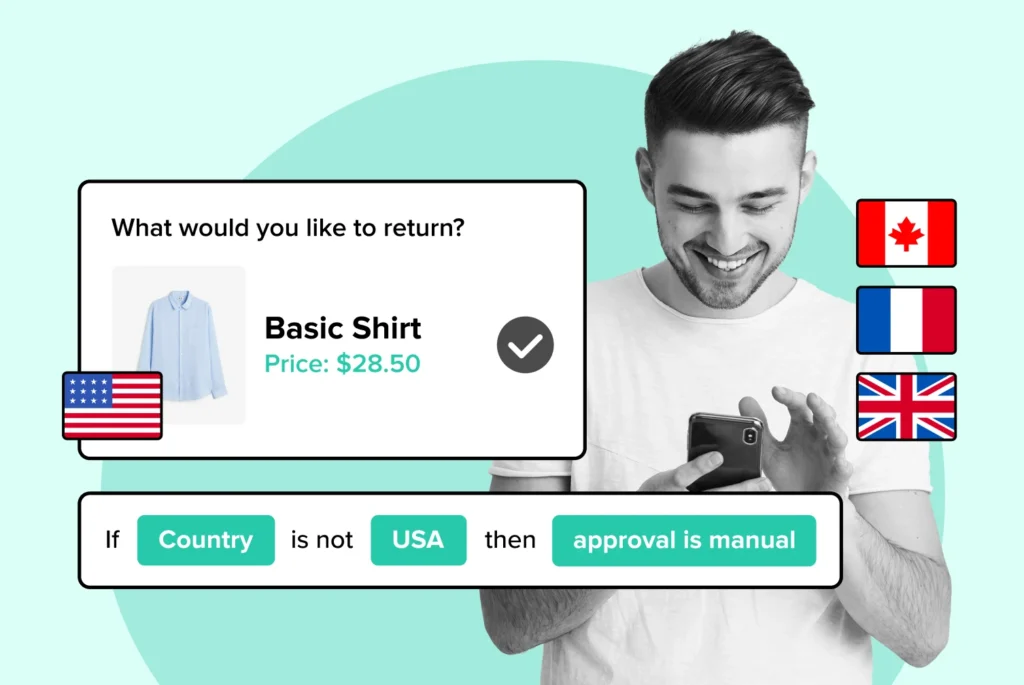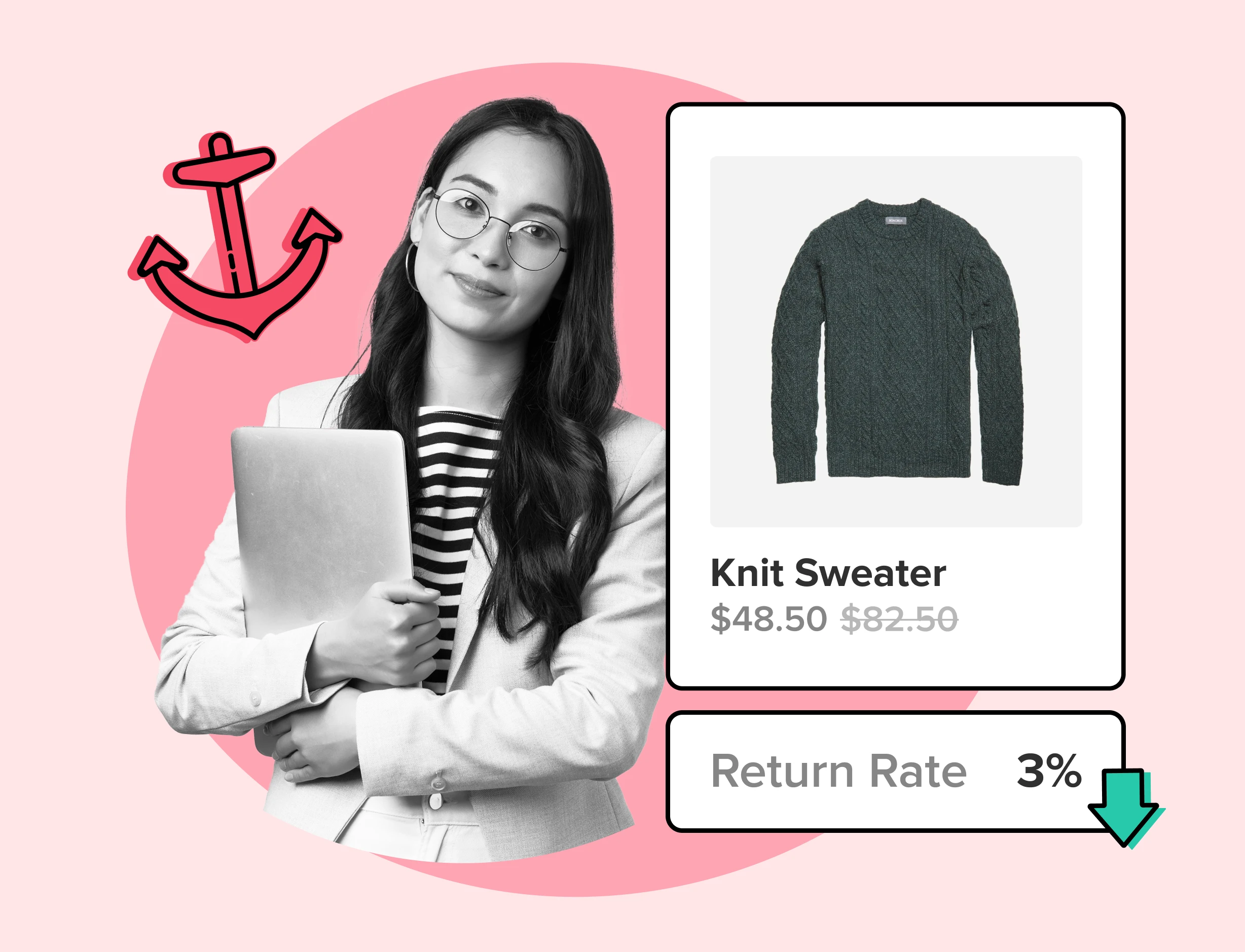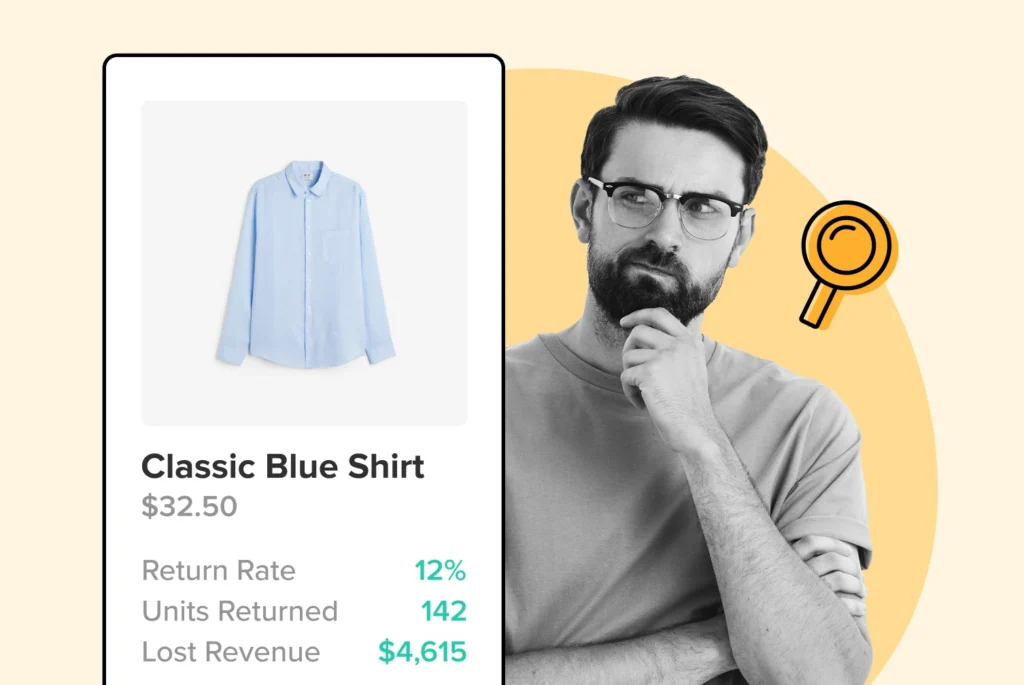
Global Returns Simplified: Your Ultimate Guide to Hassle-Free International Returns
Actionable strategies for a streamlined returns process that prioritizes customer satisfaction and operational efficiency!
Boost customer experience and reduce support tickets
Realtime order and shipment tracking
Proactive order and shipping notifications
Predictive pre-purchase estimated delivery dates
Self-Serivce branded order tracking
Effortless experience delivered
Make returns profitable and delight customers
Flexibility to define any return destinations & conditions
Simplify returns for your customers and team
Incentivize exchanges over returns
Returns management made easy for your team
Understand why your customers are returning
Unify the online and the in-store experience
Hassle-free pickup experience for customers
In-Store Dashboard to keep operations streamlined
In-Store and Online orders unified
Drive foot-traffic to your stores
Boost customer experience and reduce support tickets
Realtime order and shipment tracking
Proactive order and shipping notifications
Predictive pre-purchase estimated delivery dates
Self-Serivce branded order tracking
Effortless experience delivered
Make returns profitable and delight customers
Flexibility to define any return destinations & conditions
Simplify returns for your customers and team
Incentivize exchanges over returns
Returns management made easy for your team
Understand why your customers are returning
Unify the online and the in-store experience
Hassle-free pickup experience for customers
In-Store Dashboard to keep operations streamlined
In-Store and Online orders unified
Drive foot-traffic to your stores
Find the answer to all your questions
Explore the most comon questions about WeSupply
Calculate the ROI that WeSupply can bring you
Request a no strings attached review of your current shopping experience and missed conversion opportunities
Take a step by step trip through our functionality to see how we can improve your ecommerce processes.
Read actionable articles on how to optimize your post-purchase experience and decrease support tickets
Get inspired by stories of how our customers implemented an effortless post-purchase experience
A Deep Dive into Top Companies' Order Tracking & Returns Strategy
Wondering if WeSupply is a good fit for you? Read through our use cases to see how we can help you increase conversion & improve CX!

When it comes to customer returns, the first price a customer sees can stick and drive their decision to keep or return a product. This is known as the anchoring effect on customer returns. Our article explores how the anchor – often the initial price – can impact return rates, satisfaction, and ultimately, a business’s bottom line. Discover strategies to set the right anchors and mitigate customer returns without spoiling the detailed insights you’ll gain as you read on.
Anchoring bias plays a critical role in customer return decisions, where the initial price point can set an expectation of product quality and worth, consequently affecting satisfaction and return rates.
Setting strategic initial price points can manipulate the anchoring effect to enhance customer satisfaction by creating the perception of value or a good deal, which lowers the likelihood of product returns.
Aligning anchor prices with actual product outcomes, effectively managing online reputation, and utilizing social proof can help businesses reduce return rates by influencing customer perceptions and optimizing their post-purchase behavior.
Understanding the anchoring effect on customer returns is crucial. WeSupply offers solutions to mitigate it, including instant credit incentives, a branded returns portal, self-service returns, autogenerated QR code return labels, and returns tracking. Our integrations with platforms like Loox, Judge.me, Stamped, Yotpo, Okendo, Junip, and Reviews.io help counteract negative anchors in online reviews, positively influencing customer perceptions. Ready to optimize your post-purchase experience? Get started with WeSupply today!
At the heart of customer return decisions is a cognitive bias known as anchoring. This bias refers to our tendency to rely heavily on the first piece of information we receive – the “anchor” – when making decisions. In the context of shopping, price often serves as this anchor, influencing how customers perceive the product’s worth and quality.
Customer return decisions can be significantly impacted by anchoring bias. A customer might view a lower-priced product as inferior if their initial anchor is a higher price, despite the actual quality being comparable. Such perception can trigger returns.
On the other hand, satisfaction with a lower-priced product may stem from a higher anchor, thereby reducing returns. Comprehending the mysterious anchoring effect on consumer behavior is key for businesses that strive to curtail returns and boost customer satisfaction.
Initial price points – the first prices customers see – play a pivotal role in shaping their satisfaction with their purchases. These initial prices serve as powerful anchors that influence customer perceptions and purchasing decisions.
For instance, if the initial price point of a product is high, customers may perceive it to be of superior quality. If they purchase the product at a lower price, they may feel they’ve gotten a good deal, leading to higher satisfaction. Conversely, if the initial price is low, they may perceive the product as cheap or inferior, even if they purchase it at that price, resulting in lower satisfaction.
Anchoring effects from initial price points can deeply influence customer satisfaction and subsequent purchase evaluation. Aware of this, businesses can set initial price points strategically to positively sway customer satisfaction and lessen returns.
The anchoring effect doesn’t just shape our perceptions of price – it also influences how we perceive the value of products. This can lead to judgments and decisions that are biased by these initial anchor points, also known as anchoring biases.
For instance, customers may anchor their perceived value of a product to a plausible value that they initially encounter, such as a manufacturer’s suggested retail price. This anchor then influences their subsequent judgments about whether the actual price offers good value. If the actual price is lower than the anchor, they may perceive it as a great deal, enhancing their satisfaction and reducing the likelihood of returns.
Conversely, if the actual price is higher, they may perceive poor value, leading to dissatisfaction and increased chances of returns.
Anchoring, a manifestation of the anchoring and adjustment heuristic, represents one of various cognitive biases that sway post-purchase behavior, encompassing decisions about returns and exchanges. Cognitive biases are systematic thinking errors that impact people’s judgments and decisions.
For instance, the anchoring bias can influence post-purchase behavior by creating discrepancies between expectations and reality. If a product doesn’t live up to the high expectations set by a high anchor price, customers may feel dissatisfied and decide to return their purchase. On the other hand, if a product exceeds the expectations set by a low anchor price, customers may feel satisfied and decide to keep their purchase.
Businesses aiming to effectively manage customer post-purchase behavior need to comprehend these cognitive biases. By aligning anchor prices with actual product outcomes, businesses can positively sculpt customer perceptions and decrease return rates.
To mitigate the impact of the anchoring effect on returns, WeSupply offers tailored solutions designed to incentivize exchanges, streamline the returns process, and implement flexible return rules. By providing instant credit for exchanges, businesses can encourage customers to opt for exchanges instead of refunds, thereby reducing return rates and increasing average order values. Our self-service returns process aligns with the preferences of 70% of shoppers for a frictionless experience, saving time for both businesses and customers while giving them full control over the return process. Additionally, our platform enables businesses to create flexible return rules to accommodate various scenarios, ensuring a hassle-free return policy that enhances customer satisfaction.
Incentivize exchanges over returns
Book a quick call with our experts to see how WeSupply can help you save sales through exchanges and boost the average order value using instant store credit. to lower costs and earn back revenue.
Anchoring can also contribute to a phenomenon known as buyer’s remorse. This refers to a sense of regret customers may feel after making a purchase, often leading to product returns.
Buyer’s remorse can occur when there’s a discrepancy between the expectations set by the anchor and the actual product outcome. For example, if a customer’s anchored expectation of a product’s value is high due to a high anchor price, but the product doesn’t live up to this expectation, the customer may experience buyer’s remorse and return the product.
Conversely, if a product exceeds a customer’s anchored expectation set by a low anchor price, the customer may feel satisfied and decide to keep the product.
Anchors exert substantial influence on the decision-making process. They provide a reference point, shaping our comparisons and evaluations, and eventually, our decisions.
For instance, when shopping, customers may encounter an initial anchor – say, a product’s price. This anchor then serves as a reference point against which they compare and evaluate other prices. If a subsequent price is lower than the anchor, customers may perceive it as a good deal, making them more likely to purchase. Conversely, if a subsequent price is higher, they may perceive it as a bad deal, making them less likely to purchase.
Customer behaviors and return rates can be considerably affected by this anchor-influenced human decision-making process. By grasping this process, businesses can establish effective anchors that steer customer decisions towards preferred outcomes.
WeSupply, offers advanced returns analytics for eCommerce businesses, plays a crucial role in the decision-making process under the influence of anchors. By providing retailers with the ability to identify the most returned products and understand the specific reasons behind these returns, WeSupply offers invaluable insights into customer behavior. This data allows retailers to pinpoint which customers are serial returners and to implement targeted strategies to reduce return rates effectively. More importantly, WeSupply enables retailers to determine the exact reasons for returns, aiding in the identification of how much of their return rates are affected by anchoring biases. This insight is critical for making informed decisions to mitigate the impact of anchoring on consumer behavior and to improve the overall shopping experience.
Anchoring strategies can be an effective tool for businesses aiming to mitigate returns. By aligning customer expectations with actual product outcomes, businesses can enhance customer satisfaction and reduce the likelihood of returns.
For instance, a business could establish a realistic anchor price that truthfully represents the product’s quality. This could avert scenarios where high anchor prices result in exaggerated expectations and ensuing disappointment if the product falls short of these expectations. Similarly, a business could avoid setting an anchor price too low, which could lead to perceptions of inferior quality. By strategically setting anchor prices, businesses can manage customer expectations and reduce return rates.
WeSupply is your solution to mitigating returns through Anchoring by a range of innovative features. Key features include:
Branded Returns Portal: Elevate customer loyalty by providing a branded, omnichannel returns experience, eliminating confusion and enhancing satisfaction.
Self-Service Returns: Empower customers with complete control over the returns process, aligning with the desire for a frictionless experience expressed by 70% of shoppers.
Autogenerated QR Code Return Labels: Simplify returns for customers by enabling them to scan a QR code from their email, eliminating the need for printing.
Returns Tracking: Enhance transparency and trust by allowing customers to track the progress of their returns with ease, providing peace of mind with just a few clicks.
Establishing positive anchors is a vital element of an effective pricing strategy. These anchors can intensify the perceived product value and diminish return rates.
One common tactic is to set a high initial price as the anchor, then offer the product at a lower price. This can create the perception of a good deal, leading to increased customer satisfaction and reduced return rates.
Another tactic is decoy pricing, where a business introduces a higher-priced option to make the other options seem more attractive. This can lead to customers perceiving greater value in the lower-priced options, enhancing satisfaction and reducing returns.
By employing such pricing tactics, businesses can set positive anchors that guide customer perceptions and decisions, ultimately optimizing business outcomes.
Product presentation can significantly contribute to reinforcing anchors and swaying customer perceptions. Businesses can establish effective anchors that align with the product’s actual value by highlighting the product’s features and benefits engagingly.
For instance, a detailed product description, high-quality images, and positive customer reviews can help establish a positive anchor in the customer’s mind. This can shape their perception of the product’s value and influence their decision to keep or return it.
By enhancing product presentation, businesses can strengthen anchors, guide customer perceptions, and optimize return rates.
Anchoring can be a powerful tool in the design of customer experiences. By guiding customer perceptions and behaviors towards desired outcomes, businesses can optimize customer satisfaction and reduce return rates.
For instance, a business could design its website to highlight the original prices of products, establishing them as anchors. Then, by displaying discounted prices, the business can create the perception of a good deal, enhancing customer satisfaction and reducing the likelihood of returns. By leveraging anchoring in this way, businesses can shape the customer experience to achieve desired outcomes.
This tactic can be carried over to the post-purchase experience as well, particularly through platforms like WeSupply. By enabling retailers to set up Branded Order Tracking and Returns pages, WeSupply facilitates the continuation of anchoring strategies beyond the initial purchase. Retailers can utilize specific marketing materials within these branded environments to sustain and amplify customer engagement. This strategic approach not only reinforces brand presence but also contributes significantly to the increase in brand loyalty. Through WeSupply, retailers can seamlessly integrate anchoring into the customer journey, thereby enhancing the overall experience and fostering long-term relationships with their customers.
Eliminate shipping anxiety
Book a quick call with our experts to see how WeSupply can help you fulfill customer demands and gain long-term trust by clearly addressing order arrival times and keeping them.
Discounted price anchors can have a significant impact on return rates. These anchors can shape customer perceptions of value and influence their decisions to keep or return products.
For instance, if a customer sees a high original price crossed out and a lower discounted price, they may perceive great value in the product. This can lead to increased satisfaction and a lower likelihood of returns. However, if a customer perceives the discounted price as reflecting inferior quality, it could lead to dissatisfaction and a higher likelihood of returns.
Grasping the effects of discounted price anchors is pivotal for businesses striving to effectively control return rates.
In the e-commerce realm, comprehending and adeptly maneuvering the anchoring effect is key to managing customer returns and enhancing business outcomes.
Since customers cannot physically inspect products before purchase, they often rely heavily on price and other information as anchors to make purchasing decisions. This makes the anchoring effect particularly potent in e-commerce. Businesses can leverage this by providing detailed and accurate product information, setting realistic price anchors, and showcasing positive customer reviews to set positive anchors.
By doing so, businesses can guide customer perceptions and decisions, minimize returns, and optimize satisfaction and profitability.
Online reviews can act as potent anchors, molding customer perceptions and swaying their purchasing choices. Nonetheless, negative reviews can establish negative anchors, resulting in falling sales and rising return rates. But fear not, these negative anchors can be counteracted through strategic management and leveraging positive social proof.
For instance, businesses can actively manage their online reputation by responding to negative reviews in a constructive manner and addressing any issues raised. They can also highlight positive reviews to create positive anchors that influence customer perceptions positively. By doing so, businesses can counteract the effects of negative anchors, enhance customer satisfaction, and reduce return rates.
WeSupply’s integrations offer a robust solution for counteracting negative anchors in online reviews by emphasizing positive feedback and influencing customer perceptions. Leveraging integrations such as Loox, Judge.me, Stamped, Yotpo, Okendo, Junip, and Reviews.io, businesses can highlight positive reviews effectively. These integrations enable the collection of user-generated content and reviews via various channels such as web, email, push notifications, and SMS. By showcasing engaging visual-centric reviews, genuine text, and video reviews on their storefronts, businesses can drive sales, boost recurring sales, and reward loyal customers. With WeSupply’s integrations, creating positive anchors that positively influence customer perceptions becomes seamless and impactful.
In summary, anchoring plays a pivotal role in customer return decisions, shaping how customers perceive and evaluate products and prices. By understanding and effectively leveraging the anchoring effect, businesses can guide customer perceptions and decisions, reducing return rates and optimizing satisfaction and profitability. So, whether you’re setting initial price points, managing online reviews, or designing customer experiences, remember to keep the powerful influence of anchors in mind.
Understanding the anchoring effect on customer returns is paramount for businesses aiming to optimize their post-purchase processes. WeSupply offers a comprehensive suite of solutions tailored to mitigate the impact of anchoring, including instant credit incentives, a branded returns portal, self-service returns, autogenerated QR code return labels, and returns tracking. By leveraging these features, businesses can encourage exchanges over refunds, streamline the returns process, and enhance customer satisfaction. Additionally, WeSupply’s integrations with platforms such as Loox, Judge.me, Stamped, Yotpo, Okendo, Junip, and Reviews.io enable businesses to counteract negative anchors in online reviews, thereby positively influencing customer perceptions. Ready to optimize your post-purchase experience and reduce return rates? Get started with WeSupply today!
In marketing, the anchoring effect is commonly seen through discounts, where the original price serves as an anchor and makes the discounted price seem more appealing. This effect relies on people’s tendency to base their decisions on the first piece of information offered.
The purpose of the anchoring effect is to describe the common human tendency to rely too heavily on the first piece of information offered, affecting judgment and decision making. It plays a role in decisions involving numerical values and occurs when individuals use an initial piece of information to make subsequent judgments.
Anchoring affects consumer behavior by creating reference points for comparison, leading customers to perceive products with high prices as more valuable and desirable. This can influence their purchasing decisions significantly.
The anchoring effect refers to the tendency of customers to rely heavily on the first piece of information they receive when making decisions about returns. WeSupply offers strategies to mitigate this effect, including instant credit incentives, a branded returns portal, self-service returns, autogenerated QR code return labels, and returns tracking.
Integrations with platforms like Loox, Judge.me, Stamped, Yotpo, Okendo, Junip, and Reviews.io enable businesses to showcase positive reviews effectively, positively influencing customer perceptions and mitigating the impact of negative anchors.
Yes. WeSupply has an Official Shopify App. You can download it and start integrating with your Shopify Store.
Yes, WeSupply has an official extension for Magento. The WeSupply x Magento integration allows for automating order tracking experiences, reducing customer inquiries, automating shipping email and SMS notifications, and providing a fully branded order tracking experience
Yes, WeSupply has an official BigCommerce App. You can integrate WeSupply with your BigCommerce store to improve your post-purchase customer experience.
Learn How To Create Successful Post Purchase Email Campaigns
Build an effective post-purchase email flow that helps you increase customer satisfaction and drive revenue growth!
WeSupply is transforming the way businesses build Customer Lifetime Value by offering positive exchange experiences. By making exchanges effortless, WeSupply encourages customers to revisit your website for any product, without price constraints. Key features like using store credits or gift cards as partial payments not only increase order values but also reinforce customer loyalty. This approach is instrumental in enhancing Customer Lifetime Value, as it turns a simple exchange into a delightful shopping experience, fostering long-term customer relationships and ongoing business growth.

Actionable strategies for a streamlined returns process that prioritizes customer satisfaction and operational efficiency!

Strategies that can reduce your return-related carbon footprint, save costs, and resonate with environmentally-conscious consumers.

Discover how to allocate resources strategically, cut unnecessary costs, and position your business for scalable growth!

Let’s explore this focused rundown of the Shopify apps that a merchant needs, handpicked to power your store’s growth without excess!

How returns affect your marketing numbers: actionable strategies that harness the data from returns to balance & boost your marketing plans!

Get ready to learn essential techniques for accurate, scalable, and user-friendly product data management that drives sales!

Let’s deliver you some practical advice on choosing products, platforms, and strategies to get your online store up and running!

Prepare to exceed customer expectations and supercharge your sales with practical tactics that will elevate your e-commerce business!

How returns affect your marketing numbers: actionable strategies that harness the data from returns to balance & boost your marketing plans!